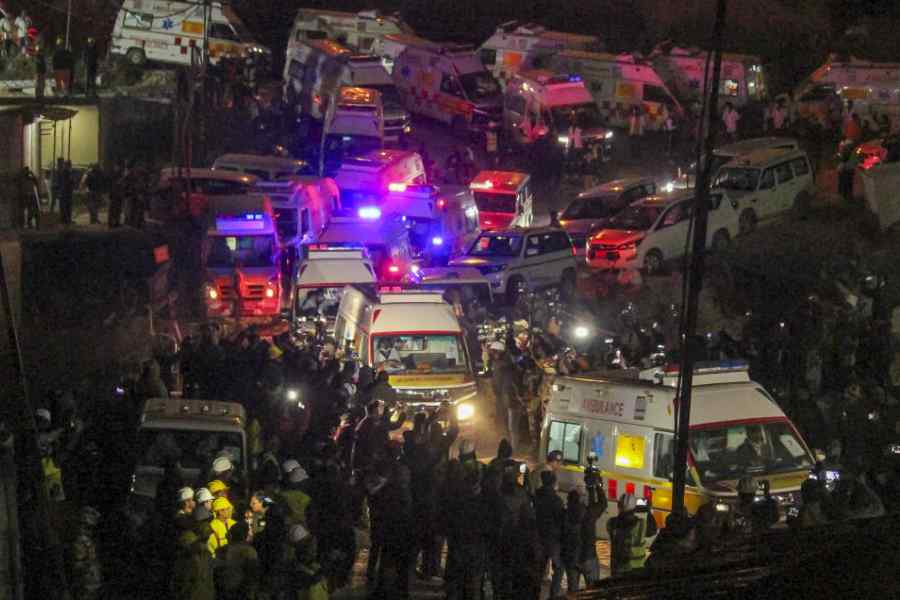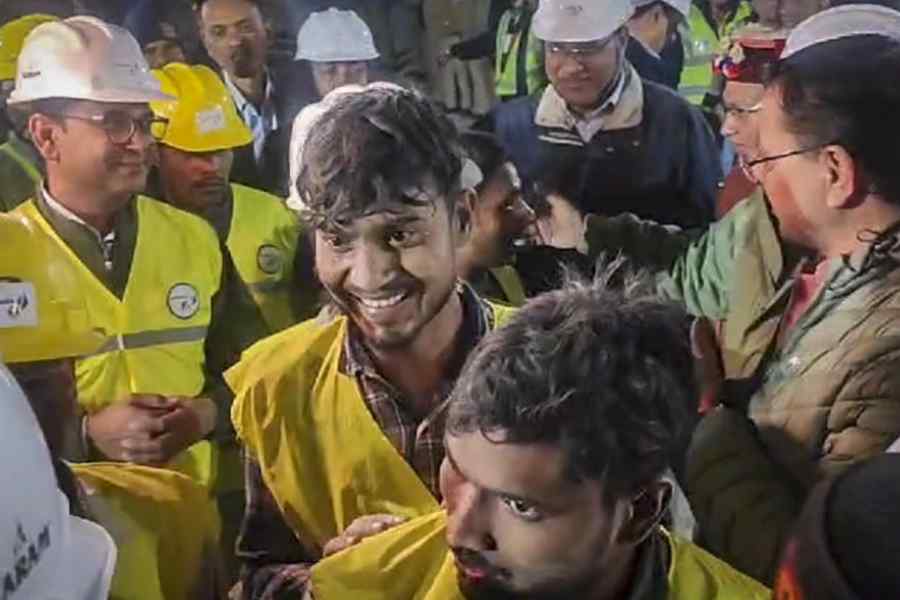The unyielding mountain debris was eventually opened up by the skill and daring of rat-hole miners and 41 trapped workers were rescued from the Silkyara Bend-Barkot Tunnel after a 16-day ordeal that swung often between hope and despair.
The rat-hole miners removed the last barrier of debris with their bare hands and rudimentary equipment after US-imported machines had drilled a channel over a fortnight pockmarked with excruciating obstacles.
Union minister V.K. Singh and Uttarakhand chief minister Pushkar Singh Dhami welcomed the workers as National Disaster Response Force (NDRF) men brought them out through an escape passage that had been created by inserting steel Hume pipes one after the other through 57 metres of rubble.
As the rat-hole miners came out after clearing 8-10 metres of debris, NDRF personnel took over and brought out the workers through the passage in stretchers. PTI quoted Dhami as saying that the youngest among the trapped workers could crawl out by themselves and did not need the help of stretchers.
An ambulance with the first of the 41 workers left the mouth of the tunnel past 8pm, about an hour after the rat-hole mining experts, brought from Delhi and who had on Monday promised to complete the job in 24 hours, dug through the last stretch of rubble. While Dhami garlanded the rescued workers, who walked out of the mouth of the tunnel, Union road transport minister Singh patted them on their back and enquired about their wellbeing.
Amid all the relief and celebration around the successful extraction of workers trapped in the mountain hole, it is perhaps essential to underline and to remember that the central nature of the stop-start rescue effort was trial-and-error ham-handedness which at no stage allowed the nation to rest in the belief that the operation was in expert hands that knew what they were doing.
Until the rescue became a visual reality on Tuesday evening, despair had repeatedly banished hope in a way that suggested the absence of a meditated rescue plan or trusted backup options.
The operation saw many actors, state and non-state — including Australian freelancer on tunnel rescue, Arnold Dix — play on the rescue stage, but none inspired collective confidence that they were working towards a cohesive plan and that a breakthrough was inevitable.
Finally, when the NDRF workers brought out the trapped labourers, the rat-hole miners came out of the tunnel smiling, their faces and hair covered in dust after having cleared the debris of sand, concrete mass, lattice, iron pipes and more at the end of an operation that began on November 12 and saw two imported auger machines airlifted to Silkyara get mangled during the drilling.
The workers used to receive water, food and medicines and were also supplied with oxygen through two pipes as they remained trapped inside a 240-metre chamber following the tunnel collapse at 5.30am on November 12.
The chief medical officer of Uttarkashi, R.C.S. Panwar, said: “They (the rescued labourers) have been taken to the Chinyalisour community health centre for an initial medical examination. There are beds ready for them. If need be, they will be airlifted to AIIMS, Rishikesh, or some other multi-specialty hospital. They all are safe. They would be under medical supervision for 48 to 72 hours before they are sent back home.”
But another medical officer said on the condition of anonymity: “They lived in crisis and without natural conditions for about 400 hours. This is bound to affect the mental condition of many of them. Its manifestation may appear after a day. It all depends on their spirit also. There are a dozen psychiatrists to treat them.”
Munna Kumar, one of the 12 rat-hole miners, said: “We worked today without having lunch because we wanted to bring them out as soon as possible.” Six of the miners had been brought to Uttarkashi on Monday morning and six more at night.
Munna said that earlier in the afternoon, when only a narrow stretch remained to be excavated, they heard the voices of the trapped labourers from the other side of the debris and informed officials.

Ambulances with rescued workers come out from the collapsed Silkyara Tunnel, in Uttarkashi district, Tuesday, Nov. 28, 2023. PTI picture
A state government official involved in the rescue operation said two rat-hole miners had felt suffocated and came out of the Hume pipe after an hour of work, gasping for breath. Doctors checked them and administered some medicines while a few other miners entered the pipe channel. “Those who were feeling sick were also back to work after 30 minutes of rest,” the official said.
The need of the rat-hole miners was felt on Sunday when the rescuers concluded that the heavy auger machine, which had drilled through more than 45 metres out of the 57 meters of rubble, was no longer able to negotiate through the mass of lattice, steel pipes and other metallic objects that infested the last 12 metres of debris. The auger, shaft and rotor had hit the metallic objects in the debris and got stuck in the Hume pipe, forcing the rescuers to halt the operation.
Equipped with traditional equipment like shovels, trowels, hammers, pans, a blower, a dust suction machine and handheld drill machines, the rat-hole miners had started working on Monday around 10pm, breaking and removing the tunnel debris, including rocks and steel fragments.
“Before that, two heavy auger machines, two dozen earth movers and other heavy drill machines, many Navratna companies, the Indian Railways, over 600 rescue workers from almost every agency in the country, many private companies, over 50 experts from across the world, two plasma cutters and a dozen gas-cutters had taken more than 360 hours to drill trough 49 metres of debris,” an Uttarakhand government official said, requesting anonymity.
Surya Mohan Rai, one of the rat-hole miners who had to briefly come out of the pipe in the afternoon, said: “We felt suffocated inside the Hume pipe. I felt a shortage of oxygen, but thought I should continue working because I could hear the muffled voices of the trapped labourers.”
Asked how they succeeded when big machines and experts were struggling, Parsadi Lodhi, another rat-hole miner, said: “We can work in less oxygen and with old equipment. We can work in very little space. We can drill through obstructions while shrinking, bending or prostrating.”
Around 1.30pm, members of the State Disaster Response Force were seen rushing into the tunnel with marigold garlands, foldable beds, mattresses, pillows, black sunglasses, folding fabric bed dividers, wheeled stretchers and ropes. All the heavy machines, including the earth movers, were driven out and an ambulance entered the under-construction mountain tunnel in reverse gear.
As the commotion increased at the mouth of the tunnel, police erected a barrier there. However, the final rescue would still take several hours.
The confusion had increased when Dhami tweeted at 2.07pm: “With the blessings of Baba Baukhnagji, the prayers of crores of countrymen and relentless labour of the teams involved in the rescue operation, the work of laying the pipes to bring out the labourers has been completed. Soon, we will bring out all the labourer brothers.”
The lack of coordination became more evident when Syed Ata Hasnain, a member of the National Disaster Management Authority, said in New Delhi at 4.30pm: “We have to clear two more metres to achieve a breakthrough. So far, the rat-hole miners have cleared 10 metres of debris in less than 24 hours with the support of the army in an operation that continues for the last about 400 hours.”
“We have been conducting this operation very carefully. There are 41 labourers trapped, but there are many more on this side who are involved in the rescue work. The lives of both are important for us and we need to retrain ourselves from making any premature declaration or rushing into anything,” Hasnain said.
However, as eight beds with oxygen cylinders, ECG machines and other medical equipment and medicines made their way into the tunnel, it appeared that the breakthrough was not far away.
Hasnain hailed the country’s leadership for “bringing together the scattered resources from across the country for the job”.
“Almost all the ministries were involved in the operation and this was the work of the leadership,” he said, listing the names of the companies that participated in the exercise.
Dhami told a news conference after the operation: “We wouldn’t have been successful without the support of Prime Minister Narendra Modi.” He announced a reward of Rs 1 lakh for every rescue worker.












